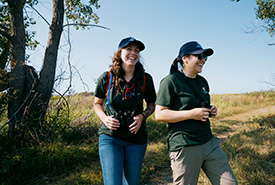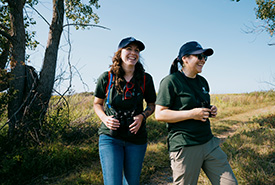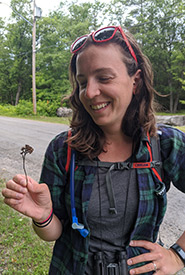NCC: Land Lines – Conserving hope

Weston Fellows at Long Point, ON (Photo Joel Rodriguez)
“How do you remain hopeful?”
I posed this question during the second annual retreat for the Weston Family Conservation Science Fellowship Program in September 2024. The other Fellows and I were sitting around our cabin’s fire pit in Norfolk County, southern Ontario, talking about conservation with current and former Nature Conservancy of Canada (NCC) staff.
Earlier in the day, we visited and learned about the decades-long fight to save a local old-growth Carolinian forest, Backus Woods. The story of persistence and ingenuity had a happy outcome, but the slow and challenging process stuck with me. At a time when awareness of humanity’s impact and reliance on nature is widespread, I am often impatient for change.
While walking in Backus Woods, I quickly forgot about the world outside the forest edge. Sunlight and blue sky peeked between gaps in the tall, dappled canopy, illuminating a mosaic of green that brings a sense of calm.

Weston Fellows at Backus Woods, ON (Photo Aerin Jacobs/NCC)
We climbed over the large trunk of a fallen tree, stopping to appreciate a smaller forest resident: a young American chestnut. It reminded me of my father, a lover of chestnuts and the person who taught me about their disappearance due to the fungal chestnut blight; the tree’s presence here a testament to decades of work poured into Backus Woods.
As we walked, I listened to the other Fellows share anecdotes and memories sparked by a rare plant or a bird call. Something resonated with each person in such a biologically diverse place. Although I bemoaned our hike’s end, as the trees thinned and the parking lot loomed, my appreciation for the beautiful patch of forest and the time taken to protect it remains today.
Next, we visited Long Point Provincial Park, and the power of collaboration took my breath away.
Looking out across the expanse of open wetland shaped by large swathes of wild rice and speckled with waterfowl, it was hard to believe the landscape was recently filled with invasive European reed. The tufted, five-metre-tall stalks of Phragmites create dense monocultures that choke out native species and destroy habitats. It is an aggressive grower, spreads easily, and takes equally aggressive management to control.
On this day, just a few ragtag stalks remained as we looked out at the water. We learned about the variety of equipment needed — boats, backpack sprayers, helicopters and drones, to name a few — for the painstaking fight against this invasive plant. But tools alone cannot do the job.

Weston Fellows at Long Point, ON (Photo Joel Rodriguez)
The eradication of Phragmites at Long Point is a community effort. People with a shared vision took action to restore the wetlands, and the fruits of such a united front are far-reaching, from benefitting the local duck hunting club to eliminating encroachment on nearby farmland.
We watched a great blue heron squabble with a great egret over perching rights, two wading birds who were likely also appreciative for the return of their wetland.
By the end of the retreat, I returned home feeling rejuvenated and held onto the excitement and wonderment for as long as possible. During long stints of isolated office work analyzing data, I often find myself reaching for inspiration.
I think back to the question I’d posed while sitting around that Norfolk County fire pit, and especially the response I received to “What gives you hope?”
Instead of incredible nuggets of wisdom I’d eagerly wished would provide some sort of epiphany, the question was turned around on me. I had looked at others in the circle while biding my time to think, and realized the answer was literally staring me in the face.
I find hope in the other research Fellows who had spent all week graciously sharing stories with me and thoughtfully listening to my own.
It was the NCC staff who mentor us and keep the fellowship program running, offering immense support in our journeys as graduate students.
And it was the new connections made during that week with conservationists, nature enthusiasts, photographers, tour guides and teachers who carry unique perspectives of nature that fuel their passion, appreciation and determination.
Next time I find myself needing a reminder for why I walk this path in conservation, I will look inward and I will reach out. Like the web of interdependent species that comprise a habitat, conservation is best supported through a collaborative network where individual strengths combine to achieve shared goals for a greener future.





